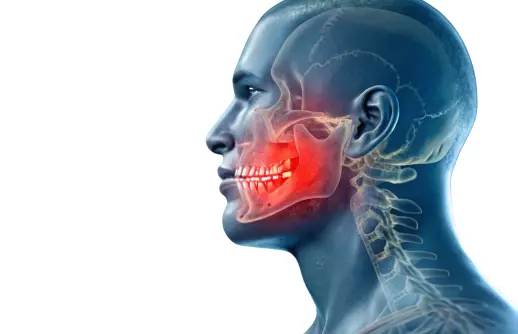TMJ vs Normal Jaw
At Dr. Amy James & Associates, we believe that understanding your jaw is the first step toward achieving long-term comfort, balance, and healthy function. Many patients are curious about TMJ vs Normal Jaw movement—why some people experience discomfort, clicking, or difficulty chewing while others use their jaw effortlessly every single day. By recognizing how a healthy jaw functions compared to one affected by TMJ issues, you can make informed decisions about your treatment and overall oral wellness.

What Is the TMJ?
The temporomandibular joint (TMJ) connects your lower jaw to your skull, functioning like a hinge with sliding motion. This remarkable joint is responsible for speaking, chewing, laughing, and yawning. When healthy, the TMJ allows smooth, coordinated movement supported by balanced muscles and a stable bite.
However, problems occur when the joint becomes strained, inflamed, or misaligned. This is where the comparison of TMJ vs Normal Jaw becomes important. A normal jaw opens quietly and without resistance, while a jaw affected by TMJ dysfunction may show signs of stress or disharmony between the joint, bite, and muscles.
TMJ vs Normal Jaw: How They Function Differently
In a normal jaw, the cushioning disc inside the TMJ stays properly positioned, helping the jaw glide comfortably. The muscles surrounding the joint work in sync, and the bite distributes pressure evenly.
When TMJ dysfunction develops, common symptoms may include:
Clicking, popping, or grinding during jaw movement
Pain in the jaw, temples, or around the ears
Difficulty opening the mouth fully
Locking sensations
Uneven or shifting jaw motion
Frequent headaches or facial tightness
The most noticeable distinction in TMJ vs Normal Jaw function is how the joint handles force. A healthy jaw absorbs pressure evenly, but a stressed TMJ may cause concentrated pressure in certain areas, leading to inflammation, muscle fatigue, and chronic discomfort.
What Causes TMJ Disorders?
TMJ problems can develop gradually or suddenly. Several factors influence how and why a person experiences dysfunction:
Teeth grinding or clenching: This places constant stress on the joint.
Misaligned bite: Uneven chewing forces make the jaw work harder.
Stress: Many people tighten their jaw subconsciously.
Injury or trauma: Even mild impacts can disrupt jaw alignment.
Arthritis: Inflammation can weaken the joint over time.
Identifying these factors helps clarify the difference between TMJ vs Normal Jaw mechanics and guides early preventive care.
Warning Signs You Should Not Ignore
Many individuals don’t realize they are developing TMJ issues until symptoms become disruptive. If you’re noticing any of the following signs, your jaw may not be functioning as it should:
Morning stiffness or soreness
Pain when chewing, talking, or opening wide
Grinding or crunching sounds
Jaw shifting to one side
Neck or shoulder tightness
Recurring headaches
These symptoms indicate that your jaw may be moving away from normal, healthy function.
How Dr. Amy James & Associates Evaluates TMJ Dysfunction
Our practice uses a comprehensive, technology-enhanced approach to assess TMJ vs Normal Jaw movement. During your evaluation, we examine your bite, jaw muscles, joint range of motion, and, if needed, take advanced imaging to pinpoint the exact cause of your discomfort.
Understanding the relationship between your bite, muscles, and joint helps us design a treatment plan that targets the root of the problem—rather than just the symptoms.
Personalized TMJ Treatment Options
Every jaw is unique, which means every treatment plan should be personalized. Based on your diagnosis, your TMJ care may include:
Custom night guards or splints to reduce clenching and improve joint stability
Orthodontic treatment to correct bite imbalances
Jaw exercises and physical therapy to promote healthier movement
Stress-management strategies to reduce unconscious tension
Restorative treatments if structural issues affect joint function
Our goal is to restore a natural, pain-free balance between your bite, muscles, and jaw joint.
Regaining Comfort and Restoring Healthy Jaw Function
Once the TMJ is properly aligned and functioning like a normal jaw, patients often notice easier chewing, fewer headaches, improved facial relaxation, and restored comfort. Understanding TMJ vs Normal Jaw alignment empowers you to take the right steps toward long-term jaw health and overall well-being.
Why Choose Dr. Amy James & Associates?
Thorough TMJ evaluation with advanced diagnostic tools
Customized and evidence-based treatment plans
Experienced team specializing in bite and jaw alignment
A patient-focused approach centered on comfort and clarity
We take pride in offering solutions that do more than relieve symptoms—we work to restore natural jaw harmony.
Schedule Your TMJ Consultation Today
If you’re experiencing jaw pain, tension, or movement concerns, the team at Dr. Amy James & Associates is here to help. Contact us today to schedule your evaluation and discover the difference between TMJ vs Normal Jaw function—and how balanced jaw health can transform your everyday comfort.
At Dr. Amy James and Associates, we believe in providing top-quality care to our community. We are proud to offer our orthodontic services to patients in Haddonfield, Haddon Township, Haddon Heights, Audubon, Cherry Hill, Greentree, Lawnside, Barrington, and the surrounding area.

